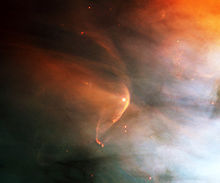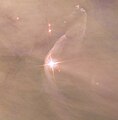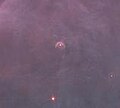Bow shock

In astrophysics, a bow shock occurs when the magnetosphere of an astrophysical object interacts with the nearby flowing ambient plasma such as the solar wind. For Earth and other magnetized planets, it is the boundary at which the speed of the stellar wind abruptly drops as a result of its approach to the magnetopause. For stars, this boundary is typically the edge of the astrosphere, where the stellar wind meets the interstellar medium.[1]
Description
The defining criterion of a shock wave is that the bulk velocity of the plasma drops from "supersonic" to "subsonic", where the speed of sound cs is defined by where is the ratio of specific heats, is the pressure, and is the density of the plasma.
A common complication in astrophysics is the presence of a magnetic field. For instance, the charged particles making up the solar wind follow spiral paths along magnetic field lines. The velocity of each particle as it gyrates around a field line can be treated similarly to a thermal velocity in an ordinary gas, and in an ordinary gas the mean thermal velocity is roughly the speed of sound. At the bow shock, the bulk forward velocity of the wind (which is the component of the velocity parallel to the field lines about which the particles gyrate) drops below the speed at which the particles are gyrating.
Around the Earth
The best-studied example of a bow shock is that occurring where the Sun's wind encounters Earth's magnetopause, although bow shocks occur around all planets, both unmagnetized, such as Mars[2] and Venus[3] and magnetized, such as Jupiter[4] or Saturn.[5] Earth's bow shock is about 17 kilometres (11 mi) thick[6] and located about 90,000 kilometres (56,000 mi) from the planet.[7]
At comets
Bow shocks form at comets as a result of the interaction between the solar wind and the cometary ionosphere. Far away from the Sun, a comet is an icy boulder without an atmosphere. As it approaches the Sun, the heat of the sunlight causes gas to be released from the cometary nucleus, creating an atmosphere called a coma. The coma is partially ionized by the sunlight, and when the solar wind passes through this ion coma, the bow shock appears.
The first observations were made in the 1980s and 90s as several spacecraft flew by comets 21P/Giacobini–Zinner,[8] 1P/Halley,[9] and 26P/Grigg–Skjellerup.[10] It was then found that the bow shocks at comets are wider and more gradual than the sharp planetary bow shocks seen at for example Earth. These observations were all made near perihelion when the bow shocks already were fully developed.
The Rosetta spacecraft followed comet 67P/Churyumov–Gerasimenko from far out in the solar system, at a heliocentric distance of 3.6 AU, in toward perihelion at 1.24 AU, and back out again. This allowed Rosetta to observe the bow shock as it formed when the outgassing increased during the comet's journey toward the Sun. In this early state of development the shock was called the "infant bow shock".[11] The infant bow shock is asymmetric and, relative to the distance to the nucleus, wider than fully developed bow shocks.
Around the Sun

For several decades, the solar wind has been thought to form a bow shock at the edge of the heliosphere, where it collides with the surrounding interstellar medium. Moving away from the Sun, the point where the solar wind flow becomes subsonic is the termination shock, the point where the interstellar medium and solar wind pressures balance is the heliopause, and the point where the flow of the interstellar medium becomes subsonic would be the bow shock. This solar bow shock was thought to lie at a distance around 230 AU[12] from the Sun – more than twice the distance of the termination shock as encountered by the Voyager spacecraft.
However, data obtained in 2012 from NASA's Interstellar Boundary Explorer (IBEX) indicates the lack of any solar bow shock.[13] Along with corroborating results from the Voyager spacecraft, these findings have motivated some theoretical refinements; current thinking is that formation of a bow shock is prevented, at least in the galactic region through which the Sun is passing, by a combination of the strength of the local interstellar magnetic-field and of the relative velocity of the heliosphere.[14]
Around other stars
In 2006, a far infrared bow shock was detected near the AGB star R Hydrae.[15]

Bow shocks are also a common feature in Herbig Haro objects, in which a much stronger collimated outflow of gas and dust from the star interacts with the interstellar medium, producing bright bow shocks that are visible at optical wavelengths.
The Hubble Space Telescope captured these images of bow shocks made of dense gasses and plasma in the Orion Nebula.
Around massive stars
If a massive star is a runaway star, it can form an infrared bow-shock that is detectable in 24 μm and sometimes in 8μm of the Spitzer Space Telescope or the W3/W4-channels of WISE. In 2016 Kobulnicky et al. did create the largest spitzer/WISE bow-shock catalog to date with 709 bow-shock candidates.[17] To get a larger bow-shock catalog The Milky Way Project (a Citizen Science project) aims to map infrared bow-shocks in the galactic plane. This larger catalog will help to understand the stellar wind of massive stars.[18]

The closest stars with infrared bow-shocks are:
| Name | Distance (pc) | Spectral type | Belongs to |
|---|---|---|---|
| *bet Cru | 85 | B1IV | Lower Centaurus–Crux subgroup |
| *alf Mus | 97 | B2IV | Lower Centaurus–Crux subgroup |
| *alf Cru | 99 | B1V+B0.5IV | Lower Centaurus–Crux subgroup |
| *zet Oph | 112 | O9.2IVnn | Upper Scorpius subgroup |
| *tet Car | 140 | B0Vp | IC 2602 |
| *tau Sco | 145 | B0.2V | Upper Scorpius subgroup |
| *del Sco | 150 | B0.3IV | Upper Scorpius subgroup |
| *eps Per | 195 | B1.5III | |
| *sig Sco | 214 | O9.5(V)+B7(V) | Upper Scorpius subgroup |
Most of them belong to the Scorpius–Centaurus association and Theta Carinae, which is the brightest star of IC 2602, might also belong to the Lower Centaurus–Crux subgroup. Epsilon Persei does not belong to this stellar association.[19]
Magnetic draping effect
A similar effect, known as the magnetic draping effect, occurs when a super-Alfvenic plasma flow impacts an unmagnetized object such as what happens when the solar wind reaches the ionosphere of Venus:[20] the flow deflects around the object draping the magnetic field along the wake flow.[21]
The condition for the flow to be super-Alfvenic means that the relative velocity between the flow and object, , is larger than the local Alfven velocity which means a large Alfvenic Mach number: . For unmagnetized and electrically conductive objects, the ambient field creates electric currents inside the object, and into the surrounding plasma, such that the flow is deflected and slowed as the time scale of magnetic dissipation is much longer than the time scale of magnetic field advection. The induced currents in turn generate magnetic fields that deflect the flow creating a bow shock. For example, the ionospheres of Mars and Venus provide the conductive environments for the interaction with the solar wind. Without an ionosphere, the flowing magnetized plasma is absorbed by the non-conductive body. The latter occurs, for example, when the solar wind interacts with Moon which has no ionosphere. In magnetic draping, the field lines are wrapped and draped around the leading side of the object creating a narrow sheath which is similar to the bow shocks in the planetary magnetospheres. The concentrated magnetic field increases until the ram pressure becomes comparable to the magnetic pressure in the sheath:
where is the density of the plasma, is the draped magnetic field near the object, and is the relative speed between the plasma and the object. Magnetic draping has been detected around planets, moons, solar coronal mass ejections, and galaxies.[22]
See also
Notes
- ^ Sparavigna, A.C.; Marazzato, R. (10 May 2010). "Observing stellar bow shocks". arXiv:1005.1527 [physics.space-ph].
- ^ Mazelle, C.; Winterhalter, D.; Sauer, K.; Trotignon, J.G.; et al. (2004). "Bow Shock and Upstream Phenomena at Mars". Space Science Reviews. 111 (1): 115–181. Bibcode:2004SSRv..111..115M. doi:10.1023/B:SPAC.0000032717.98679.d0. S2CID 122390881.
- ^ Martinecz, C.; et al. (2008). "Location of the bow shock and ion composition boundaries at Venus - initial determinations from Venus express ASPERA-4". Planetary and Space Science. 56 (6): 780–784. Bibcode:2008P&SS...56..780M. doi:10.1016/j.pss.2007.07.007. S2CID 121559655.
- ^ Szego, Karoly (18 July 2003). "Cassini plasma spectrometer measurements of Jovian bow shock structure". Journal of Geophysical Research: Space Physics. 108 (A7): 1287. Bibcode:2003JGRA..108.1287S. doi:10.1029/2002JA009517.
- ^ "Cassini encounters Saturn's bow shock". Department of Physics and Astronomy, University of Iowa.
- ^ "Cluster reveals Earth's bow shock is remarkably thin". European Space Agency. 16 November 2011.
- ^ "Cluster reveals the reformation of the Earth's bow shock". European Space Agency. 11 May 2011.
- ^ Jones, D. E.; Smith, E. J.; Slavin, J. A.; Tsurutani, B. T.; Siscoe, G. L.; Mendis, D. A. (1986). "The Bow wave of Comet Giacobini-Zinner - ICE magnetic field observations". Geophys. Res. Lett. 13 (3): 243–246. Bibcode:1986GeoRL..13..243J. doi:10.1029/GL013i003p00243.
- ^ Gringauz, K. I.; Gombosi, T. I.; Remizov, A. P.; Szemerey, I.; Verigin, M. I.; et al. (1986). "First in situ plasma and neutral gas measurements at comet Halley". Nature. 321: 282–285. Bibcode:1986Natur.321..282G. doi:10.1038/321282a0. S2CID 117920356.
- ^ Neubauer, F. M.; Marschall, H.; Pohl, M.; Glassmeier, K.-H.; Musmann, G.; Mariani, F.; et al. (1993). "First results from the Giotto magnetometer experiment during the P/Grigg-Skjellerup encounter". Astronomy and Astrophysics. 268 (2): L5–L8. Bibcode:1993A&A...268L...5N.
- ^ Gunell, H.; Goetz, C.; Simon Wedlund, C.; Lindkvist, J.; Hamrin, M.; Nilsson, H.; LLera, K.; Eriksson, A.; Holmström, M. (2018). "The infant bow shock: a new frontier at a weak activity comet" (PDF). Astronomy and Astrophysics. 619: L2. Bibcode:2018A&A...619L...2G. doi:10.1051/0004-6361/201834225.
- ^ "APOD: 2002 June 24 - the Sun's Heliosphere and Heliopause".
- ^ "NASA - IBEX Reveals a Missing Boundary At the Edge Of the Solar System". Archived from the original on 2013-03-07. Retrieved 2012-05-12.
- ^ McComas, D. J.; Alexashov, D.; Bzowski, M.; Fahr, H.; Heerikhuisen, J.; Izmodenov, V.; Lee, M. A.; Möbius, E.; Pogorelov, N.; Schwadron, N. A.; Zank, G. P. (2012). "The Heliosphere's Interstellar Interaction: No Bow Shock". Science. 336 (6086): 1291–1293. Bibcode:2012Sci...336.1291M. doi:10.1126/science.1221054. PMID 22582011. S2CID 206540880.
- ^ Detection of a Far-Infrared Bow Shock Nebula around R Hya: The First MIRIAD Results
- ^ Spitzer Science Center Press Release: Red Giant Plunging Through Space
- ^ "VizieR". vizier.u-strasbg.fr. Retrieved 2017-04-28.
- ^ "Zooniverse". www.zooniverse.org. Retrieved 2017-04-28.
- ^ melinasworldblog (2017-04-26). "Close Bowshocks". Melina's World. Retrieved 2017-04-28.
- ^ Lyutikov, M. (2006). "Magnetic draping of merging cores and radio bubbles in clusters of galaxies". Monthly Notices of the Royal Astronomical Society. 373 (1): 73–78. arXiv:astro-ph/0604178. Bibcode:2006MNRAS.373...73L. doi:10.1111/j.1365-2966.2006.10835.x. S2CID 15052976.
{{cite journal}}: CS1 maint: unflagged free DOI (link) - ^ Shore, S. N.; LaRosa, T. N. (1999). "The Galactic Center Isolated Non-thermal Filaments as Analogs of Cometary Plasma Tails". Astrophysical Journal. 521 (2): 587–590. arXiv:astro-ph/9904048. Bibcode:1999ApJ...521..587S. doi:10.1086/307601. S2CID 15873207.
- ^ Pfrommer, Christoph; Dursi, L. Jonathan (2010). "Detecting the orientation of magnetic fields in galaxy clusters". Nature Physics. 6 (7): 520–526. arXiv:0911.2476. Bibcode:2010NatPh...6..520P. doi:10.1038/NPHYS1657. S2CID 118650391.
References
- Kivelson, M. G.; Russell, C. T. (1995). Introduction to Space Physics. New York: Cambridge University Press. p. 129. ISBN 978-0-521-45104-8.
- Cravens, T. E. (1997). Physics of Solar System Plasmas. New York: Cambridge University Press. p. 142. ISBN 978-0-521-35280-2.
External links
- NASA Astronomy Picture of the Day: Bow shock image (BZ Cam) (28 November 2000)
- NASA Astronomy Picture of the Day: Bow shock image (IRS8) (17 October 2000)
- NASA Astronomy Picture of the Day: Zeta Oph: Runaway Star (8 April 2017)
- Bow shock image (HD77581)
- Bow shock image (LL Ori)
- More on the Voyagers
- Hear the Jovian bow shock (from the University of Iowa)
- Cluster spacecraft makes a shocking discovery (Planetary Bow Shock)














